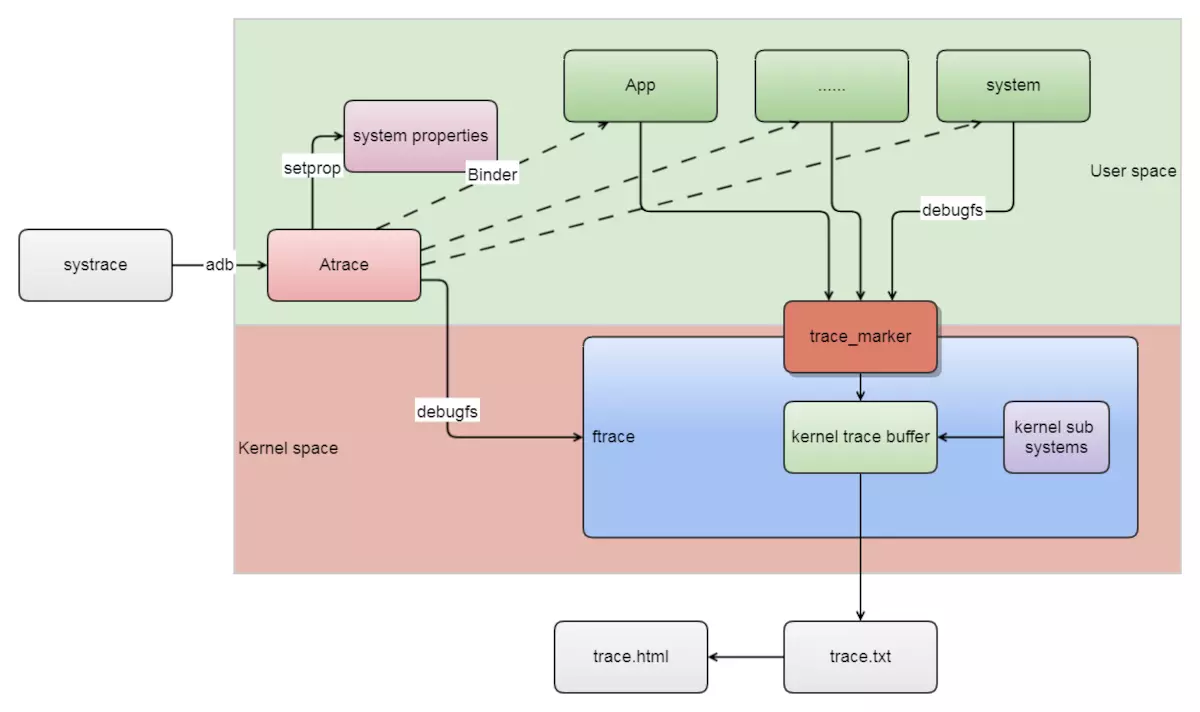1 简介
https://www.lizenghai.com/archives/26061.html
2 用法
用命令行启动Systrace抓取采样:《Capture a system trace on the command line》
自定义采样的方法:《Define custom events》这个方法确实要仔细看,尤其是采样命令的描述,强调了要使用 -a 参数,之前我忽略了这一点,导致自定义的标签总也显示不出来。
python systrace.py -a com.autonavi.amapauto -b 16384 -o my_systrace_report.html sched freq idle am wm gfx view binder_driver hal dalvik camera input res
【坑】采用Android Device Monitor来抓取Systrace时有一个坑,就是经常出现Java heap error(因为我自动插桩所有函数,导致Systrace标签数量庞大),后来发现原因在于Monitor配置的Java堆最大值太小了,收集trace数据时需要大量的堆(怀疑是做数据合并加工)引发堆空间错误。解决方法如下:
1. 找到Monitor脚本所在目录,里面有libmonitor-x86,例如:C:Usersliuheng.klhAppDataLocalAndroidSdk oolslibmonitor-x86(或monitor-x86_64) 2. 打开monitor.ini 配置文件,修改如下三项空间配置(尽可能大点就行): -XX:MaxPermSize=1024m -Xms2048m -Xmx4096m
(1)实现自定义标签
在Android 6.0(API 23)中包含trace.h,可以在Native层直接进行引用,获取函数指针进行调用。用 ATRACE_CALL 宏直接在需要插桩的函数入口调用一下即可。关键代码:

1 #include <android/trace.h> 2 3 ///////////////////////////////////////////////////////////////////// 4 // utils.h 5 extern void *(*_ATrace_beginSection) (const char* sectionName) __attribute__ ((no_instrument_function)); 6 extern void *(*_ATrace_endSection) (void) __attribute__ ((no_instrument_function)); 7 extern bool *(*_ATrace_isEnabled) (void) __attribute__ ((no_instrument_function)); 8 9 // SysTrace 10 class ScopedTrace { 11 const char* _name; 12 public: 13 static bool _bInit; 14 static void init() __attribute__ ((no_instrument_function)); 15 16 typedef void *(*fp_ATrace_beginSection) (const char* sectionName); 17 typedef void *(*fp_ATrace_endSection) (void); 18 typedef bool *(*fp_ATrace_isEnabled) (void); 19 20 public: 21 inline ScopedTrace(const char* name) __attribute__ ((no_instrument_function)) { 22 if (!_bInit) { 23 init(); 24 } 25 _ATrace_beginSection(name) ; 26 27 _name = name; 28 //LOGD("_ATrace_beginSection(%s) _ATrace_isEnabled()=%d", name, _ATrace_isEnabled()); 29 } 30 31 inline ~ScopedTrace() __attribute__ ((no_instrument_function)) { 32 _ATrace_endSection(); 33 //LOGD("_ATrace_endSection(%s) _ATrace_isEnabled()=%d", _name, _ATrace_isEnabled()); 34 } 35 }; 36 37 #define ATRACE_NAME(name) ScopedTrace ___tracer(name) 38 #define ATRACE_CALL() ATRACE_NAME(__FUNCTION__) 39 40 ///////////////////////////////////////////////////////////////////// 41 // utils.cpp 42 void *(*_ATrace_beginSection) (const char* sectionName) = NULL; 43 void *(*_ATrace_endSection) (void) = NULL; 44 bool *(*_ATrace_isEnabled) (void) = NULL; 45 46 bool ScopedTrace::_bInit = false; 47 void ScopedTrace::init() { 48 if (_bInit) { 49 return; 50 } 51 52 // Retrieve a handle to libandroid. 53 void *lib = dlopen("libandroid.so", RTLD_NOW || RTLD_LOCAL); 54 55 // Access the native tracing functions. 56 if (lib != NULL) { 57 // Use dlsym() to prevent crashes on devices running Android 5.1 58 // (API level 22) or lower. 59 _ATrace_beginSection = reinterpret_cast<fp_ATrace_beginSection>( 60 dlsym(lib, "ATrace_beginSection")); 61 _ATrace_endSection = reinterpret_cast<fp_ATrace_endSection>( 62 dlsym(lib, "ATrace_endSection")); 63 _ATrace_isEnabled = reinterpret_cast<fp_ATrace_isEnabled>( 64 dlsym(lib, "ATrace_isEnabled")); 65 } 66 67 LOGI("lib=%p, _ATrace_beginSection=%p, _ATrace_endSection=%p, _ATrace_isEnabled=%p, ATrace_isEnabled()=%d", 68 lib, _ATrace_beginSection, _ATrace_endSection, _ATrace_isEnabled, _ATrace_isEnabled()); 69 70 _bInit = true; 71 }
(2)一个巧妙的利用——编译器自动插桩
利用gcc的 “-finstrument-functions” 可以实现自动化插桩。关键代码如下:

1 // utils.h 2 extern "C" { 3 4 void __cyg_profile_func_enter( void *, void * ) __attribute__ ((no_instrument_function)); 5 void __cyg_profile_func_exit( void *, void * ) __attribute__ ((no_instrument_function)); 6 7 } 8 9 // utils.cpp 10 #define DUMP(func, call) LOGI("[KLH]%s: func = %p, called by = %p ", __FUNCTION__, func, call) 11 12 extern "C" { 13 14 void __cyg_profile_func_enter(void *this_func, void *call_site) { 15 //DUMP(this_func, call_site); 16 char addr[32]; 17 snprintf(addr, 32, "%p", this_func); 18 19 ScopedTrace::init(); 20 21 if (0 != _ATrace_isEnabled && _ATrace_isEnabled()) { 22 _ATrace_beginSection(addr); 23 } 24 } 25 26 void __cyg_profile_func_exit(void *this_func, void *call_site) { 27 //DUMP(this_func, call_site); 28 29 if (0 != _ATrace_isEnabled && _ATrace_isEnabled()) { 30 _ATrace_endSection(); 31 } 32 } 33 34 }
这里关键的点是需要extern "C"声明原型。
(3)编写一套Python(其他语言也行)工具来翻译加工自动插桩的函数(运行时)地址为函数名。翻译的方法为:
1. 获取进程pid: adb shell ps | adb shell grep [进程名] 分解字符串第一个即是 2. 获取进程maps adb shell cat /proc/[pid]/maps 3. 提取trace.html(Systrace报告)中所有运行时地址列表,准备翻译 4. 提取所有so的地址段,以此来确定运行时地址所属so及内部相对地址 5. 提取so内部相对地址与符号映射表 readelf -sW libXXX.so 6. 根据4、5翻译出运行时地址对应的函数符号,并翻译出函数名 c++filt -n [symbol] 7. trace.html中线程名缺失的问题可以进一步补充(如果线程中途退出则可能遗漏): adb shell cat /proc/pid/task [foreach] tid adb shell cat /proc/pid/task/tid/status 得到Name:字段就是线程名称
3 原理


